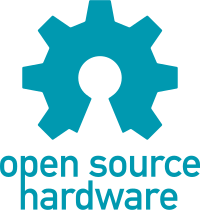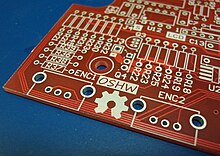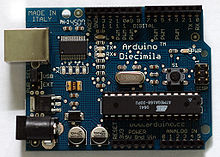Open-source hardware
Open-source hardware (OSH, OSHW) consists of physical artifacts of technology designed and offered by the open-design movement.[citation needed] The term usually means that information about the hardware is easily discerned so that others can make it – coupling it closely to the maker movement.HDL descriptions are commonly used to set up system-on-a-chip systems either in field-programmable gate arrays (FPGA) or directly in application-specific integrated circuit (ASIC) designs.[11] In early 1999, Sepehr Kiani, Ryan Vallance and Samir Nayfeh joined efforts to apply the open-source philosophy to machine design applications.[16] Around 2010 in context of the Freedom Defined project, the Open Hardware Definition was created as collaborative work of many[17] and is accepted as of 2016 by dozens of organizations and companies.Javier Serrano, an engineer at CERN's Beams Department and the founder of the Open Hardware Repository, explained: "By sharing designs openly, CERN expects to improve the quality of designs through peer review and to guarantee their users – including commercial companies – the freedom to study, modify and manufacture them, leading to better hardware and less duplication of efforts".[19] While initially drafted to address CERN-specific concerns, such as tracing the impact of the organization's research, in its current form it can be used by anyone developing open-source hardware.[25][26] The FOSSi Foundation is founded in 2015 as a UK-based non-profit to promote and protect the open source silicon chip movement, roughly a year after the official release of RISC-V architecture.Open Source Ecology is a large project which seeks to develop a complete ecosystem of mechanical tools and components which aim to be able to replicate themselves.A large range of open-source mechatronic products have been developed, including machine tools, musical instruments, and medical equipment.Examples of open source medical equipment include open-source ventilators, the echostethoscope echOpen, and a wide range of prosthetic hands listed in the review study by Ten Kate et.al.As a result, the phrase "free as in speech, not as in beer",[61] more-formally known as gratis versus libre, distinguishes between the idea of zero cost and the freedom to use and modify information.While open-source hardware faces challenges in minimizing cost and reducing financial risks for individual project developers, some community members have proposed models to address these needs[62] Given this, there are initiatives to develop sustainable community funding mechanisms, such as the Open Source Hardware Central Bank.[66] All these terms are examples of the open-source model applicable for the development of any product, including software, hardware, cultural and educational.[68][69][70] Other sources of open-source hardware production are vendors of chips and other electronic components sponsoring contests with the provision that the participants and winners must share their designs.[74] For example, littleBits implements open-source business models by making available the circuit designs in each electronics module, in accordance with the CERN Open Hardware License Version 1.2.For example, to accelerate development and technical innovation, the photovoltaic industry has experimented with partnerships, franchises, secondary supplier and completely open-source models.[82] Additionally, while open-source hardware may reduce pressure on natural resources and local populations, it still relies on energy- and material-intensive infrastructures, such as the Internet.Despite these complexities, Kostakis et al argue, the open-source hardware framework can serve as a catalyst for connecting and unifying diverse local initiatives under radical narratives, thus inspiring genuine change.






RepRap3D printerartifactsopen-design movementfree and open-source softwaremaker movementschematicsbills of materialintegrated circuitdrivesreturn on investmentopen-source licensemodular designcommunity collaborationprogrammable logic deviceshardware description languagesystem-on-a-chipfield-programmable gate arraysapplication-specific integrated circuitsemiconductor intellectual property coresproprietary device driversdevice driversopen sourceBruce PerensOpen Source DefinitionOpen Source Initiativeham radio operatorOpen DesignGNU General Public LicenseOpenCores3D printingArduinoAdafruitSparkFunOpen Source EcologyOpen Graphics ProjectOpen Hardware FoundationTucson Amateur Packet Radio CorporationTAPR Open Hardware LicenseEric S. RaymondFreedom DefinedEuropean Organization for Nuclear ResearchCERN OHLFree Software FoundationOpen Source Hardware AssociationFOSSi FoundationRISC-VFour FreedomsWikiHousemass spectrometryOpenRISCOpenSparcinstruction set architecturehardware description languagesmechatronicsmechatronicUltimakerLasersauropen-source ventilatorsOpen source robotics3D printed firearmDefense Distributedpatent lawBSD licensesoftware licensespatentcopyrightCERN Open Hardware LicenseApache LicenseCreative Commons Attribution-ShareAlikepermissive licensesFreeBSD licenseMIT licenseCreative Commons AttributioncopyleftsilkscreenedInternetgratis versus libreopen-source softwareopen-source appropriate technologyopen source product developmentopen-source model3-D printingOpen-Source Lab (book)Joshua Pearceopen-source electronicsopen-source labsBoston Open Source Science LaboratoryBrigham Young UniversityMichigan TechNational Tsing Hua UniversityOSU Open Source LabOregon State UniversityOpen Source Research LabUniversity of Texasbusiness modelslittleBitsopen-source business modelsCERN Open Hardware License VersiontrademarkphotovoltaiccrowdfundingIndiegogoKickstarterCrowd SupplyRichard Stallmanfree softwareopen source softwareAlternative terms for free softwaresustainable developmentOpen-Source Lab: How to Build Your Own Hardware and Reduce Research Costsfree and open-source hardwarescientistsfacultyHardwareXJournal of Open HardwareComputer numeric controlFab labHardware backdoorList of open-source hardware projectsList of open-source mobile phonesOpen-source roboticsOpen innovationOpen manufacturingRapid prototypingSimputer